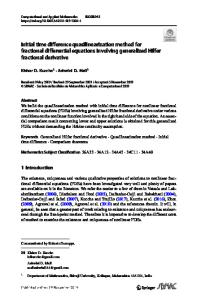Generalized Mittag-Leffler quadrature methods for fractional differential equations
- PDF / 847,266 Bytes
- 16 Pages / 439.37 x 666.142 pts Page_size
- 49 Downloads / 420 Views
Generalized Mittag-Leffler quadrature methods for fractional differential equations Yu Li1 · Yang Cao1 · Yan Fan2 Received: 3 April 2020 / Revised: 23 June 2020 / Accepted: 28 June 2020 © SBMAC - Sociedade Brasileira de Matemática Aplicada e Computacional 2020
Abstract In this paper, we propose a generalized Mittag-Leffler quadrature method for solving linear fractional differential equations with a forcing term. The construction of such a scheme is based on the variation-of-constants formula which has a generalized Mittag-Leffler function in the kernel, and incorporates the idea of collocation methods and the local Fourier expansion of the system. The properties of the methods are analyzed. The numerical experiments show the high effectiveness of the new methods. Keywords Linear fractional differential equation · Caputo fractional derivative · Local Fourier expansion · Generalized Mittag-Leffler function · Collocation method Mathematics Subject Classification 65L20 · 26A33 · 34A08
1 Introduction In recent decades, fractional differential equations (FDEs) have attracted growing interest in many fields of science and engineering. The theoretical analysis and numerical approximation of FDEs have gained a great development in both theory and application. Due to the non-locality of fractional-order operators, the theoretical investigation and the establishment of numerical methods for FDEs are more complicated compared with the integer-order case, see Diethelm (2010), Garrappa et al. (2018), Miller and Ross (1993) and Podlubny (1999).
Communicated by Vasily E. Tarasov.
B
Yan Fan [email protected] Yu Li [email protected] Yang Cao [email protected]
1
Department of Mathematics, Northeast Forestry University, Harbin 150040, People’s Republic of China
2
College of Mathematics and Computer Science, Zhejiang Normal University, Jinhua 321004, People’s Republic of China 0123456789().: V,-vol
123
215
Page 2 of 16
Y. Li et al.
One of the major difficulties in the development of numerical methods for FDEs is to obtain sufficiently high accuracy. Usually, the true solutions of FDEs lack smoothness and, therefore, the classical numerical methods for ordinary differential equations (ODEs) based on polynomial replacements, such as Adams multistep methods and predictor–corrector techniques, usually fail to provide satisfactory results when applied to fractional order problems (see Diethelm et al. 2004; Li and Tao 2009). Exponential integrators which involve the exponential function of the linear term have been proposed for semilinear ODEs. These integrators permit larger step sizes and achieve higher accuracy than classical ones for stiff differential equations such as semidiscrete timedependent partial differential equations. We refer to Hochbruck and Ostermann (2010) for a review of exponential integrators for ODEs. Nowadays, several exponential integrators are extended to fractional problems and they are proved to be more accurate and efficient for FDEs. A generalized exponential time differencing method was constru
Data Loading...











